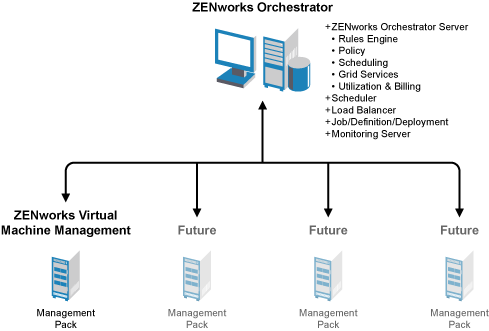1.1 Introduction
The following sections contain information to help introduce you to ZENworks Orchestrator:
1.1.1 What Is ZENworks Orchestrator?
ZENworks Orchestrator 1.2 uses its functional components to:
-
Perform high-performance-computing-style task breakdown across multiple machines (resources) in a data center
-
Provide distributed, CRON-style job scheduling
-
Provide a messaging system between the ZENworks Orchestrator Server and the managed machines
The Orchestrator system consists of a central server (the Orchestrator Server), agents capable of executing work on each managed resource, and an optional client application (the ZENworks Orchestrator Console) that can be used to drive and monitor the Orchestrator system. Work is described to the system in the form of a “job.” A job is written in an embedded Python* script and deployed to and managed by the server. When a job is run, constraint-based placement (a kind of rules engine) directs the work to suitable and available resources. The job might partially execute on the managed systems and can further execute any process as the desired user on the managed system.
The following figure illustrates how ZENworks Orchestrator is used as the basic building block for the ZENworks Virtual Machine Management Pack (VM Management), which is available as a separate product, and future management packs to be developed and released by Novell.
Figure 1-1 ZENworks Orchestrator and Management Packs

ZENworks VM Management adds increased functionality to Novell ZENworks Orchestrator. If you purchase this management pack, you will be able to deploy predefined jobs to manage the life cycle of various virtual machine technologies, including the ability to move files around in both unicast and multicast distribution modes. This Orchestrator capability helps administrators, IT operators, and job developers improve and expand the performance of the data center by automating provisioning and by using Virtual Machines (VMs) as resources in the data center computing environment. Better managed VMs can help control associated data center costs by addressing several data center issues, including cooling, space, power usage, and efficient hardware usage. For more information about ZENworks Virtual Machine Management, see the Novell ZENworks Orchestrator 1.2 Virtual Machine Management Guide.
1.1.2 The Purpose of This Guide
The purpose of this guide is to introduce you to the basic Orchestrator components (that is, the Orchestrator components that provide high performance computing functions and are basic to Orchestrator Management Packs that can be purchased separately), to help you plan the installation of these components, to install them, and to help you understand how to use them in basic usage scenarios.
For information about installing and using the Virtual Machine Management capabilities of ZENworks Orchestrator, see the Novell ZENworks Orchestrator 1.2 Virtual Machine Management Guide.
1.1.3 The Audience for This Guide
The contents of this guide are of interest to the following individuals:
Administrator: An Orchestrator administrator deploys applications, manages users, and monitors distributed computing resources. Administrators can also create and set policies for automating the usage of these computing resources. For more information about the tasks and tools used by the Administrator, see the Novell ZENworks Orchestrator 1.2 Administration Guide.
User: The end user of ZENworks Orchestrator, also called a “Job Manager,” runs and manages jobs that have been created by a Job Developer and deployed by the administrator. It is also possible that the end user could be a developer who has created applications to run on distributed computing resources. For more information about the tasks and tools used by the Job Manager, see the Novell ZENworks Orchestrator 1.2 Job Management Guide.
Developer: The developer has control of a self-contained development system where he or she creates jobs and policies and tests them in a laboratory environment. When the jobs are tested and proven to function as intended, the developer delivers them to the Orchestrator administrator. For more information about the tasks and tools used by the Job Developer, see the Novell ZENworks Orchestrator 1.2 Developer Guide and Reference.